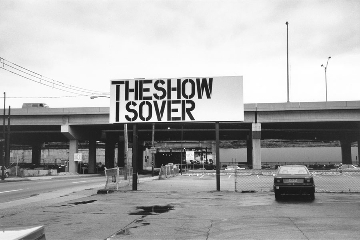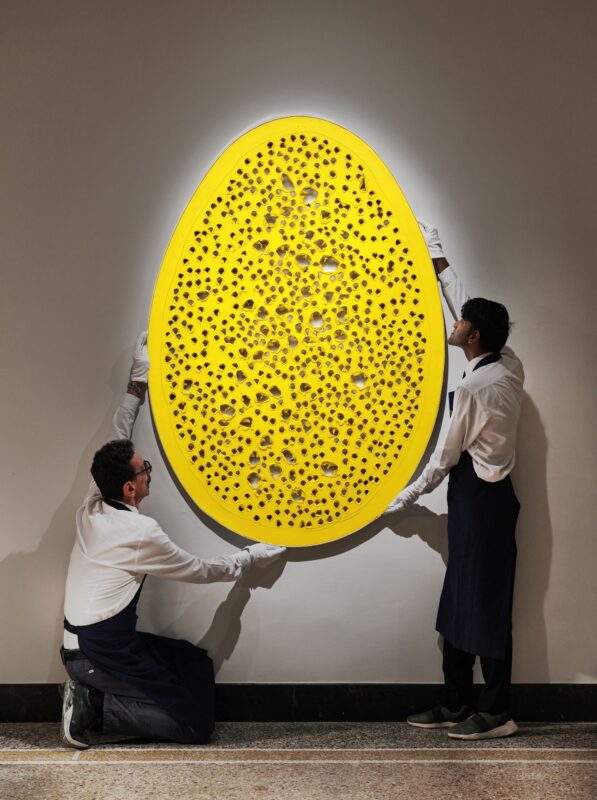
OCTOBER 15th – NOVEMBER 30th, 2013 6-24 Britannia Street London WC1X 9JD
Opening reception: Tuesday, October 15th, from 6:00 to 8:00 pm
There it is. I have shown it to you. It has been done. It is being done. And because it can be done, it will be done.
—Kirk Varnedoe, Pictures of Nothing
“The show is over.” Or is it? This exhibition is about abstraction and the end of painting, often proposed but never concluded. Christopher Wool’s statement in paintings, drawings and billboards, taken from Vasily Rozanov’s nineteenth century definition of nihilism, contains sufficient irony to suggest that painting itself, the spectacle that surrounds it, and the ultimate questions it poses about life and death, are never quite over.
The negation of painting emerged in Europe after WWII in Francis Picabia’s last paintings, Lucio Fontana’s punctured and slashed Concetto spaziale paintings, Yves Klein’s Fire-Color works, and Piero Manzoni’s quest for neutral materiality in the Achromes. When first exhibited in 1953, Robert Rauschenberg’s White Paintings—monochromatic panel paintings—were unprecedented in their deceptive blankness. These works anticipated diverse interpretations of the neutral picture plane. Gerhard Richter’s paintings of the 1970s in shades of grey project a removed, indifferent power. Richard Serra’s Left Corner Horizontal (1977), a dense black expanse of oilstick on linen, produces a physical and spatial void that appears impenetrable.
A shared spirit of negation is evident in the anarchic actions that fueled the urban Punk movement, epitomized by Steven Parrino’s physical attacks on the canvas and Kim Gordon’s evanescent wreaths. In Parrino’s Untitled (1992), the anarchist symbol is sprayed in black engine enamel on white vellum. Ed Ruscha’s hermetic painted wordplay reaches cinematic finality with The End paintings, begun in the early 1980s. The silhouettes of Hourglass #4 (1987) and End (1993) are set against grey-spectrum horizons that evoke transitions of time and space.
Seeking new ways to negate or efface the picture plane, artists such as Douglas Gordon, Mark Grotjahn, Wade Guyton, Adam McEwen, Albert Oehlen, Richard Prince, and Rudolf Stingel represent sustained challenges to the limits of painting, both real and imagined.
“The Show is Over” continues the thread of Gagosian exhibitions such as “Imageless Icons: Abstract Thoughts” (2005); “Crash” (2010); and “Malevich and the American Legacy” (2011), which trace art-historical themes from the advent of Modernism to the present.
Please join the conversation with Gagosian Gallery on Twitter (@GagosianLondon) and on Instagram (@gagosiangallery) via the hashtag #ShowisOver.
Artists in Exhibition
Dan Colen,Willem de Kooning,Jeff Elrod,Lucio Fontana,Felix Gonzalez-Torres,Douglas Gordon,Mark Grotjahn,Wade Guyton,Gregor Hildebrandt,Neil Jenney,Mike Kelley,Yves Klein,Roy Lichtenstein,Nate Lowman,Piero Manzoni,Brice Marden,Adam McEwen,Albert Oehlen,Steven Parrino,Francis Picabia,Sigmar Polke,Richard Prince,Robert Rauschenberg,Gerhard Richter,Ed Ruscha,Robert Ryman,Richard Serra,Frank Stella,Rudolf Stingel,Blair Thurman,Cy Twombly,Andy Warhol,Christopher Wool,Richard Wright.
Categories
Tags
- Adam McEwen
- Albert Oehlen
- Andy Warhol
- Blair Thurman
- Brice Marden
- Christopher Wool
- Cy Twombly
- Dan Colen
- Douglas Gordon
- ED RUSCHA
- Felix Gonzalez-Torres
- Francis Picabia
- Frank Stella
- Gerhard Richter
- Gregor Hildebrandt
- Jeff Elrod
- Lucio FONTANA
- Mark Grotjahn
- Mike Kelley
- Nate Lowman
- Neil Jenney
- Piero Manzoni
- Richard Prince
- Richard Serra
- RICHARD WRIGHT
- Robert Rauschenberg
- Robert Ryman
- Roy Lichtenstein
- Rudolf Stingel
- Sigmar Polke
- Steven Parrino
- Wade Guyton
- Willem de Kooning
- Yves Klein









